 |
| July 12, 2016 | Volume 12 Issue 26 |
Designfax weekly eMagazine
Archives
Partners
Manufacturing Center
Product Spotlight
Modern Applications News
Metalworking Ideas For
Today's Job Shops
Tooling and Production
Strategies for large
metalworking plants
Wheels:
Porsche takes a look back at its four-cylinder engine history
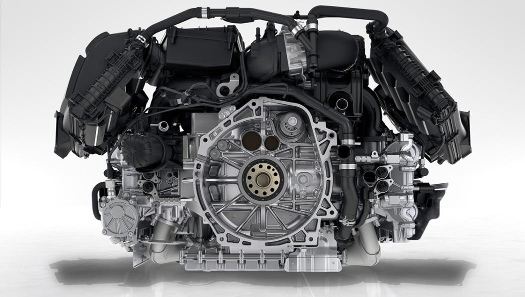
Porsche's new four-cylinder flat, 2016 [All photos credit: Porsche AG]
The market launch of the new Porsche 718 Boxster this week represents the first time since the late 1960s that Porsche is producing sports cars with four-cylinder flat engines.
This time around, and 20 years after the first Boxster made its debut, Porsche is restructuring its mid-engine roadsters. The designation for the new generation of models is 718 Boxster and 718 Boxster S.
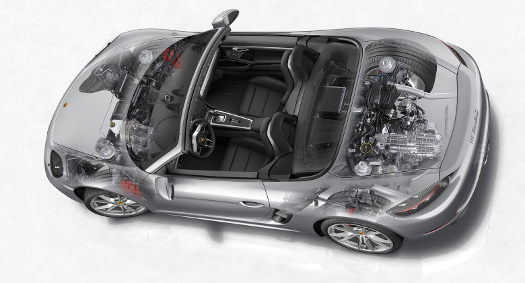
718 Boxster S, 2016
The launch presents a nice opportunity to take a drive down memory lane through Porsche's four-cylinder engine history.
1948: Porsche 356
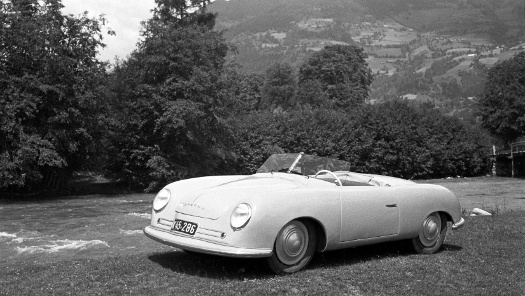
356 Nr. 1 Roadster, Gmünd, 1948, Porsche AG
In July 1948, a murmur makes its way through the village of Gmünd in Kärnten. A vehicle drives through the idyllic town in the Alps -- a car unlike any other the world had ever seen: stylish and dynamic, sporty, infinitely elegant. The Porsche 356 glistens in the Austrian summer sunshine. It is the first vehicle with the official brand name "Porsche." Previously, the automotive design office of Ferdinand Porsche had developed all of its vehicles in the name of other manufacturers.
The first Porsche had a four-cylinder engine, and it won over car fans -- not only by its charming appearance, but also by its fast-paced character. The very first 356 prototype (production number 1) raced a fast demonstration lap at the city street race in Innsbruck. Back then, it still had a mid-engine; later in production, it was replaced by a rear-mounted engine. The engine in the 356 is an old acquaintance. It is based on the Volkswagen flat engine that was developed by the Porsche design office in the 1930s. After Innsbruck, it could no longer be held back. There is hardly a classic race the car has not won: the 24 Hours of Le Mans, the 1,000 Kilometers of Buenos Aires, the Mille Miglia, Targa Florio, Carrera Panamericana. The Porsche 356 was always out at the front.
1953: Porsche 550 Spyder
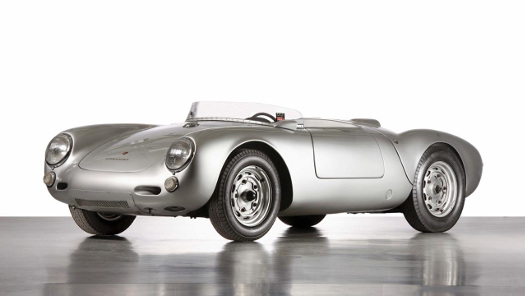
550 Spyder, 1953, Porsche AG
In 1952, Porsche KG decided to become involved in manufacturer's racing. The Porsche race car was to be compact, powerful, and fast -- and above all, lightweight to ideally utilize the engine's power. Engineers went to work and created the 550 Spyder: mid-engine construction, ultralight aluminium body, 550-kg unladen weight, and a four-cylinder flat engine that made itself heard quite loudly. Named the Fuhrmann engine after its designer, the engine developed a respectable 110 hp thanks to four camshafts. That was 60 hp more than the first 356 engine just five years prior. It catapulted the Spyder to high speeds up to 220 km/h (137 mph).
Its performance at the Targa Florio in 1956 was legendary. At this tradition-rich endurance race in Sicily, Umberto Maglioli and Huschke von Hanstein went to the start in a Porsche 550 A. And they finished victorious -- with a full 15-minute lead over even the six- and eight-cylinder competition.
1957: Porsche 718
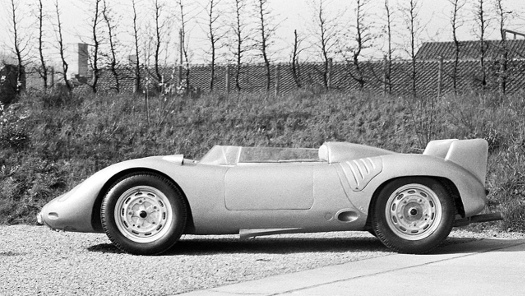
718 RSK Spyder, Porsche AG
Once again, race engineers accomplished a tremendous task. Despite the visual similarities to its predecessor, the 550 Spyder, the performance data of the Porsche 718 RSK spoke a unique language. At first, 148 hp, and in the 718 RS60 with 1.6 liters of displacement an impressive 160 hp, were teased from the four-cylinder engine. With an unladen weight of just 530 kg, the 718 also trimmed some significant weight compared to the 550 A Spyder that weighed 550 kg. The mid-engine sports car could now sweep over the asphalt at a maximum speed of 260 km/h (162 mph).
Thanks to this increase in performance, the Porsche 718 even surpassed the success of its predecessor. At the Targa Florio, the 718 was overall victor in 1959 and 1960; it raced to a class victory in 1958 and 1961, and it was the uninterrupted European Hill Climb Champion from 1958 to 1961. The 718 was also modified into a single-seater and competed in Formula-2 and Formula-1 racing.
1963: Porsche 904 Carrera GTS
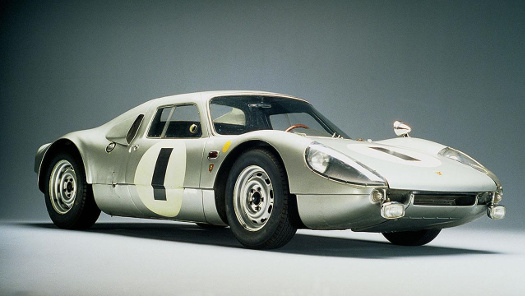
904 Carrera GTS, Le Mans 1964, Porsche AG
An innovation at Porsche: the steel box frame of the Carrera GTS is joined to a body made of polymer. The glass fiber-reinforced polyester resin developed by BASF gives the car body an elementary advantage: lightness. And it made genuine racers out of the stylistically confident rockets designed by Ferdinand Alexander Porsche with their characteristic design -- not only in motorsport competitions, but also in the hands of individual customers. Demand for the elegant mid-engine sports car was so high that in addition to the 100 units needed for homologation, an additional 16 Carrera GTS cars were built.
In 1964, the Carrera GTS achieved a prestigious victory. After 720 high-paced kilometers over dusty streets and through tight bends, after seven hours and 10 minutes of wild driving along the coast of Northern Sicily, Antonio Pucci and Colin Davis charged across the finish line in first place at the Targa Florio. Once again, the Fuhrmann engine, Porsche's proven four-cylinder flat engine, put on a winning display for its class.
1976: Porsche 924
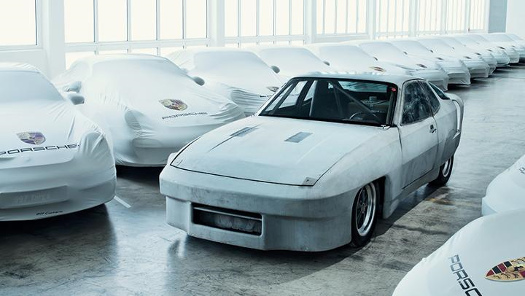
924, exhibition "top secret," Porsche museum, 2014, Porsche AG
To introduce its new model, Porsche planned a high-speed drive. It optimized a Porsche 924 to set an endurance speed record. The goal was to drive the car a distance of 10,000 miles at an average speed of over 250 km/h (155 mph). The engineers souped up the standard turbocharged four-cylinder engine to 250 hp, and the aerodynamics of the 924 were further perfected in the wind tunnel. This boosted the top speed of the endurance sports car to 280 km/h (174 mph). However, the record attempt would never take place; shortly before the drive planned in July 1977, the project was stopped for strategic reasons.
As a topical response to the oil crisis of the early 1970s, it was decided that the production 924 would be equipped with an efficient four-cylinder in-line engine. For the first time, Porsche also employed a water-cooled front engine in combination with a transaxle gearbox at the rear axle. In the base version, the compact sports car had a power output of 125 hp, and the S versions up to 160 hp. The turbocharged engine of the 924 Carrera GT even reached 210 hp and a top speed of 240 km/h (149 mph).
In successor models to the 924 (the 944 and 968), the designers remained true to the combination of an in-line four-cylinder engine and the transaxle concept. The 944 became one of the most successful sports cars of its time -- and it saved Porsche AG through the economically turbulent 1980s.
1981: Porsche 944
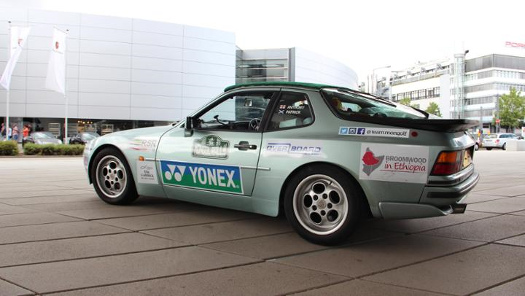
1986 Porsche 944, Zuffenhausen, 2015, Porsche AG
In one of the successor models to the 924, the 944, the designers remained true to the combination of an in-line four-cylinder engine and the transaxle concept. In 1981, it closed the gap between the entry-level 924 model and the 911 SC. With 163 hp and a list price of 38,900 DM, the 944 was positioned precisely between the two models. The centerpiece of the 944 was its newly engineered, naturally aspirated engine with 2.5 liters of displacement. The in-line four-cylinder engine is based on the right cylinder bank of the eight-cylinder engine of the Porsche 928. Thanks to the use of two Lanchester balancer shafts, the 944 engine was smoother running than many six-cylinder engines. Its digital engine electronics and L-Jetronic fuel injection also pointed the way to the future.
2014: Porsche 919 Hybrid
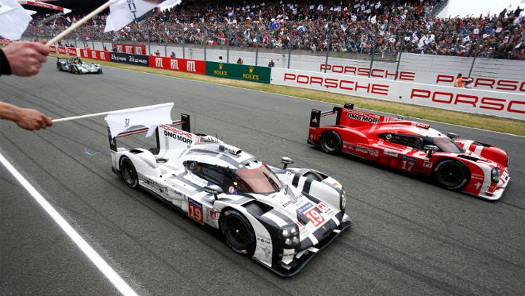
919 Hybrid Nr 19, 919 Hybrid, Nr 17, Finish Line, Le Mans, 2015, Porsche AG
In the FIA World Endurance Championship (WEC), new efficiency rules have been in force since 2014. They are strict, necessitating a sort of deep pass for the ambitious race car engineers in Weissach. It is a tremendous challenge that promises, along with fame and glory on the race course, genuine benefits for future production-car technologies at Porsche.
For Porsche, this was a convincing argument for re-entering competition in the premiere class of racing in the 2014 WEC season after 16 years of abstinence. The candidate: the Porsche 919 Hybrid. Its revolutionary drive concept combined an extremely compact, highly turbocharged 2-liter four-cylinder engine with a powerful electric motor on the front axle. Two energy-recovery systems and highly advanced lightweight carbon construction provided for maximum efficiency.
The ultimate stress test for the 919 Hybrid: Le Mans. At the legendary 24-hour race, the two prototypes had a strong race in 2014. Toward the end of the competition, however, they had to bow out due to technical problems.
In the months that followed, the motorsport department in Weissach had a singular purpose: produce the perfect 919 Hybrid for the 2015 season -- with even more power, better reliability, higher performance. The rocket was optimized in nearly all of its details -- and in the end it achieved its long-awaited first and second place victory at Le Mans.
2016: Porsche 718 Boxster
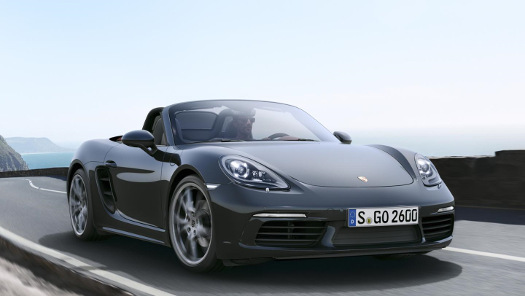
718 Boxster, 2016
The two-seat convertibles are more powerful and more fuel efficient. With them, Porsche continues the tradition of the four-cylinder flat engines that were used in the Porsche 718 mid-engine sports cars that won numerous races back in the 1950s and 1960s, among them being the legendary Targa Florio and Le Mans.
The centerpiece of the new model series is the newly developed four-cylinder flat engine with turbocharging. The 718 Boxster develops 220 kW (300 hp) of power from two liters of engine displacement, while the 718 Boxster S attains 257 kW (350 hp) from 2.5 liters of displacement. In the S-model, Porsche also uses a turbocharger with variable turbine geometry (VTG). In fact, Porsche is now the only manufacturer to offer VTG technology in production cars with gasoline-driven engines, both in the 911 Turbo and in the 718 Boxster S. Impressive here is the considerable power gain of 26 kW (35 hp) compared to the previous Boxster models and the efficiency of the new turbo engines. The new 718 Boxster models have fuel economy improvements of up to 13 percent.
The completely new chassis tuning and stronger brakes provide for passionate and sporty driving. The design of the new model line was also comprehensively advanced. The vehicle was completely revised except for the luggage compartment lids, the windscreen, and the convertible top. Inside, a newly designed dash panel frames the cockpit. In addition, the latest generation of Porsche Communication Management (PCM) with a state-of-the-art touchscreen is included as standard. The navigation module is available as an option.
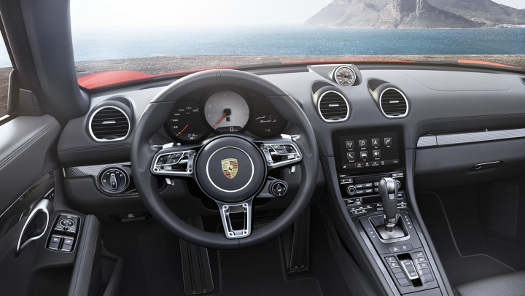
Interior, 718 Boxster, 718 Boxster S, 2016
In its driving dynamics, the new roadster follows in the tracks of the original 718. The car's completely retuned chassis enhances cornering performance. The electromechanical steering system is configured to be 10 percent more direct. This makes the 718 Boxster even more agile and easier to steer, both on circuit tracks and in everyday traffic.
Available at extra charge for the roadsters is Porsche Active Suspension Management (PASM) with a 10-mm lower ride height. For the first time, the PASM sport chassis with a 20-mm lower ride height is available as an option for the 718 Boxster S. The active chassis, which has also been retuned, offers an even broader spread between long-distance touring comfort and dynamic sporty stiffness.
The market launch of the new mid-engine sports car is April 30.
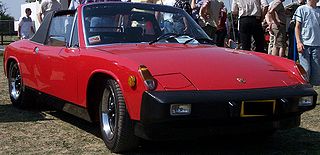
[Photo by Stahlkocher, distributed under a CC-BY 3.0 license]
Editor's note: To all the readers who wrote in to say this article left out the Porsche 914, the mid-engine, targa-top two-seater that saw production between 1969 and 1976, all we can say is, "You were right -- and thank you."
This Porsche-Volkswagen collaboration featured both flat-four and flat-six engine types. "The 914 was available as a flat 4 cylinder air-cooled engine or traditional flat 6 used in the 911 w/o a turbo," said RS, one of our readers.
"It was a VW engine first in 1.7 and 1.8L variants; the 2.0L used Porsche designed heads," said GO, another Designfax reader.
The 914 flat four became Porsche's top seller during its model run, outselling the Porsche 911.
Designfax reader NRS: I had a 1974 Porsche 914 in high school, and it was a fuel injected, air cooled, flat-four.between 1973-1975, they had 1.7, 1.8,and 2.0 litre versions. In your defense it is kind of a forgettable car, but still, mid-seventies was the last flat-four Porsche. I think the 912 was around in the early seventies, too. 911 body, but with a flat-four.
Designfax reader CraigB: Also left out are the Porsche 912 and 912E that used 356 and 914 2.0 motors respectively in a 911 chassis.
Source: Porsche
Published April 2016
Rate this article
View our terms of use and privacy policy
